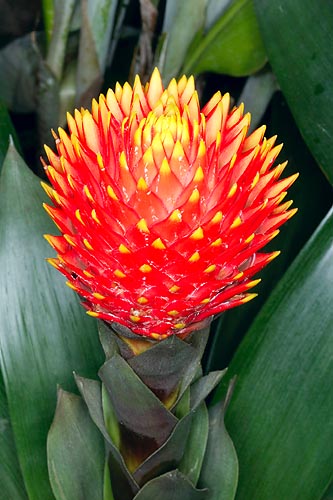Family : Bromeliaceae

Text © Pietro Puccio

English translation by Mario Beltramini

Showy, pine-shaped inflorescence © Giuseppe Mazza
The Guzmania conifera (André) André ex Mez (1896) is native to the humid forests of Ecuador and Peru between the 1300 and 1700 m of altitude.
The genus is honoured to the Spanish naturalist Anastasio Guzman (†1807); the Latin name of the species, “conifera” = coniferous, cone-bearing, refers to the shape of the inflorescence.
Common names: “cone-headed guzmania (English).
Evergreen herbaceous plant, monocarpic (bearing fruit only one time during its existence), acaulescent, epiphytic or terrestrial, up to 1 m tall, inflorescence included, it has a rosette of unarmed glossy dark green leaves, 60-80 cm long and 6-8 cm broad. The floral scape, at the centre of the rosette, robust and rigid, is 40-60 cm long and is covered by bracts similar to the leaves in the lower part, lanceolate and reddish on the upper one. The scape ends with an inflorescence cone-shaped, about 14 cm long, formed by thickly superposed floral bracts, rigid, triangular, about 4 cm long, of a bright red colour with gold yellow tips, which last for several months. The flowers, inside the bracts, are yellowish and about 6 cm long, and are short lasting.
Besides by seed, it reproduces by vegetative way through the new plants which come out from axillary gemmae between the leaves, it is cultivable in open air, in a slightly shaded position, in the tropical and humid subtropical climates, both as epiphytic and as terrestrial on very aerated, porous, draining and rich of organic substance substrata. Elsewhere, it is to be cultivated in pot in luminous location, but far from direct sun, with temperatures over the 14-16°C, best 20-24°C, even if it is able to bear, if dry, temperatures just over the 0°C for a short time.
The substratum is to be kept constantly humid in summer, slightly in winter, and the ambient humidity, in presence of dry air and high temperatures, can be increased with nebulisations by utilizing water at room temperature and not calcareous in order to avoid anti-aestethic dots on the leaves. In summer, some water can be left in the central cavity formed by the rosette of the leaves, renewing the same frequently for avoiding the formation of a nest of mosquito larvae, whilst in winter it is better to leave it dry, thus avoiding possible rottenness. For stimulating the blossoming in the mature plants, a simple method is to hood the plant with a transparent plastic film and place at the base for about two weeks, one-two ripe cut apples (the ripe fruit, in particular the apple, develops ethylene, hormone which helps the blossoming of the Bromeliaceae).
Synonyms: Caraguata conifera André (1888).
→ For general notions about BROMELIACEAE please click here.
